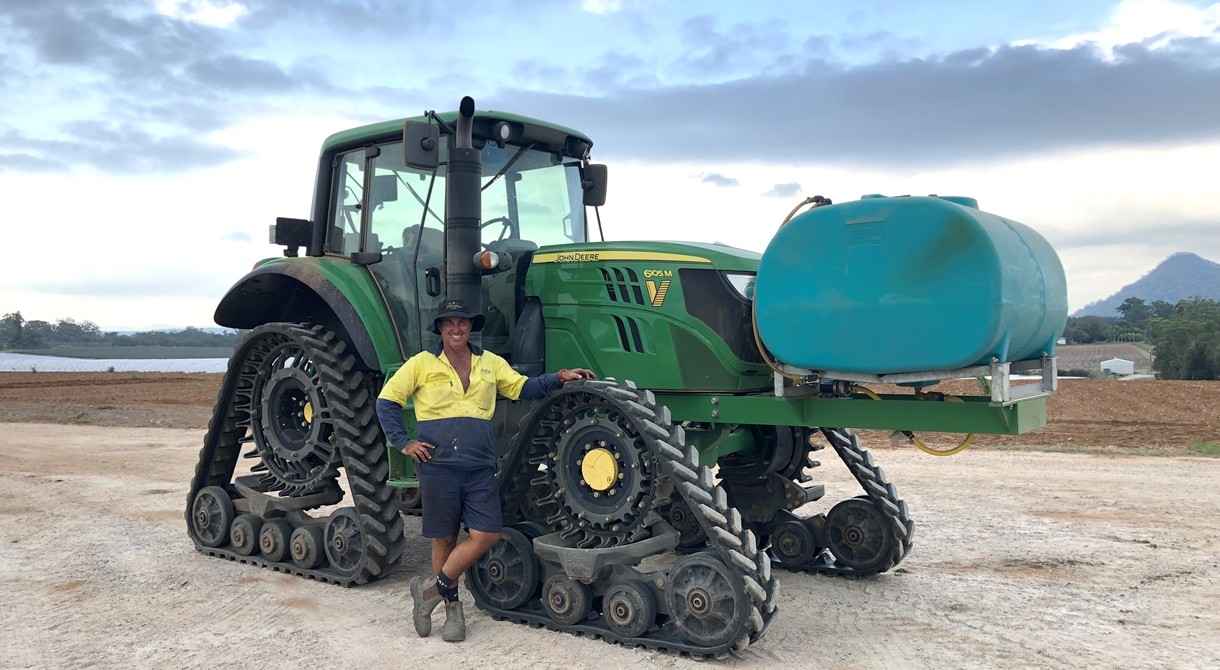
Piñata Farms' strawberry farm manager Jason Dipple discusses how traditional broadacre practices have been adapted for horticulture.
Combining the tried and tested farming practices of four generations of one family in south-east Queensland with new technologies and farming ingenuity is a hallmark of Piñata's philosophy.
Resourcefulness is driven by the need to farm more efficiently and economically and, if there's a way to stretch the value of equipment or machinery by thinking laterally, we'll find it. An example of this is our use of a John Deere tractor with tracks, which was designed and manufactured primarily for traditional broadacre farming but which is boosting productivity in our south-east Queensland strawberry operations. We're not aware of any other commercial strawberry growers using a tractor in this way.
Piñata Farms diversified into strawberry production in 2000, after some 40 years of growing pineapples in the Wamuran district of the Sunshine Coast. By 2017, the winter open-field strawberry operations had expanded significantly to about 45 hectares, producing fruit from June to October. With approximately 2.5 million plants under cultivation and a year 'round cycle of preparation and post-harvest activities, every piece of infrastructure or equipment needs to work at full capacity.
A recurring challenge on the strawberry farm has always been downtime during and after rain. When we looked for a solution, our objective was to get back onto the farm sooner after rain to work through muddy blocks and walkways.
We worked with agricultural machinery dealer Vanderfield and found the solution in a John Deere 6105M tractor. It's a medium-sized unit supplied with tyres which Vanderfield replaced with tracks by Soucy, the global provider of interchangeable rubber track systems to meet our needs. The bolt-on units reduce compaction and increase flotation on wet ground, providing more power to the ground.
Since acquiring it last July, the tractor, which has a hydraulic system including a three-point hitch that can easily handle heavy implements and loads, has boosted production time including bed preparation and laying plastic at the start of the season, spraying the crop and lifting plastic and knocking down hills at the end of the season. It's been able to cover more ground, more efficiently.
Previously after rain, we had to wait a day or two to get into the patch and then lay down timber boards to drive over. That was both time-consuming and unrewarding.
With tracks, we can drive straight into the patch in any weather. There's also no compaction, which is better for drainage and, because the soil is freer, it's easier to get the plastic down into the sub-soil and hold. And with 105 horsepower on board, there's plenty of power to prevent wheel spin which can be an issue on a tractor with tyres, resulting in a loss of traction and making it more difficult to pull implements. The 6105M is in use every day and easily manages the full breadth of jobs.
Productivity boosts:
1. Lifting plastic now easy in any conditions
Lifting plastic after heavy rain has always been a challenge. If it was too wet, we had to wait because it was not an efficient use of time or resources. In one period in the past when the blocks were particularly wet, it took six or eight men a week and a half to pull plastic from the back of a tractor by hand because the ground was too wet to pull a standard tractor with a cutter bar over the ground. Now, with the cutter bar fitted to the new tractor, we can lift plastic in any conditions, taking about three and a half hours. Any time saved in lifting plastic means we can meet the planting schedule with ease.
2. No spraying downtime
Spraying is the tractor's main job as the entire crop is sprayed every four days during the growing season, from a week after planting in March to the end of October. The tractor carries a 1,000 litre chemical tank on the front and a 1,250 litre air-assisted, converted spray tank on the back. We constructed our own frame to hold the front tank. Now there's no downtime after rain as we can access the patch when we want and there's no chance of getting bogged.
3. Mulching equipment reduced from two tractors with rotary hoes to one tractor
The 6105M proved its weight in gold just before last Christmas when we had some heavy rain at Wamuran. Previously, it would have taken two tractors – each fitted with a rotary hoe – six days to chip the sorghum cover crop into the ground. Instead, we used the 6105M alone to pull a tilling disc over it.
There are more than 40 tractors in use throughout the various farm locations in Queensland and the Northern Territory. Most are John Deere products yet the 6105M is the only one with tracks. Its versatility is unquestionable and, for a tractor with tracks, it's comfortable and operator friendly.
However, the sole purpose we bought it was for the tracks. It was built to work hard and we've made it work harder. This coming winter marks a full year on the farm and we expect it will provide a return on investment within a few seasons.
